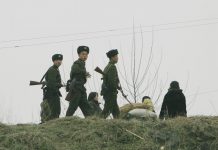
The North Korean military has ordered frontline naval units on both coasts to strengthen radar surveillance and develop a system for joint operations with ships on maritime patrol duty, Daily NK has learned.
“The operations departments of the First Squadron in the East Sea and the Eighth Squadron in the Yellow Sea received orders from the General Staff Department of the Korean People’s Army [KPA] on Feb. 26 to increase their maneuverability and ability to handle combat situations,” a source in the North Korean military told Daily NK on Monday, speaking on condition of anonymity. “They are to do this by establishing a joint operations system with naval vessels on maritime patrol duty and defining a specific mission for maritime radar surveillance in March when North Korea’s winter drills end.”
While overseeing the test launch of a new anti-ship missile on Feb. 14, North Korean leader Kim Jong Un described the Northern Limit Line (NLL) in the Yellow Sea as a “phantom border without any legal pretext or basis in international law” and ordered the North Korean military to increase its readiness and draw a “maritime national boundary” north of Baengnyong Island and Yonpyong Island in defiance of the NLL.
The orders of the KPA General Staff Department appear to be part of subsequent efforts to strengthen the navy at both the strategic and tactical levels.
“Following the message from Kim Jong Un, the navy has been working on replacing the military term ‘maritime demarcation line’ with ‘maritime national boundary’ and revising the notation of sea routes at naval commands and fleets in the Yellow Sea and East Sea,” the source said.
Interestingly, the General Staff Department’s orders were delivered by wireless communication. In peacetime, orders are usually given by telephone or through documents carried by couriers. However, these orders were delivered by wireless communication, which is preferred in wartime and other crises.
The wireless transmission was meant to assess whether Marine units are routinely maintaining combat readiness and whether the wartime system for sending and receiving orders is functioning, the source explained.
“Following the order to focus on maritime radar surveillance in March, the First and Eighth Squadrons have shortened radar surveillance shifts from two hours to one hour. This measure takes into account the fact that crewmembers who monitor radar screens for their entire shift tend to lose focus after a while,” the source said.
Military places emphasis on “joint operations”
This month, the First and Eighth Squadrons also plan to focus on field exercises to test the joint operations system with ships on maritime patrol duty.
In these drills, the source explained, the operations departments of the First and Eighth Squadrons are supposed to immediately inform patrol vessels of any suspicious objects detected on maritime radar, and after being informed, the patrol vessels are supposed to immediately set an intercept course.
“As part of the orders, the General Staff Department instructed the squadrons to test the joint operation system by regularly presenting war scenarios and evaluating [service members’ performance] in March,” the source said.
“The General Staff Department stressed that the operations departments of the First and Eighth Squadrons must accurately monitor the situation with their radars and skillfully conduct joint operations with maritime patrol vessels to not only respond to enemy incursions across the maritime national border but also deal with defections by ‘impure elements’ at sea,” the source added.
Translated by David Black. Edited by Robert Lauler.
Views expressed in this guest column do not necessarily reflect those of Daily NK. Please send any comments or questions about this article to dailynkenglish@uni-media.net.

















